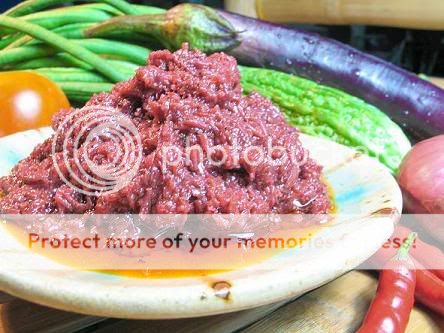The penchant for sawsawan is noticeable in a typical Pinoy table setting that includes a platito and different condiments on the dining table. Check also their cupboards and you'll surely find different bottles of dipping sauces used as flavoring for cooking as well as seasoning for cooked meals. I just checked mine and was surprised that I'm well stocked hehe...
I've got Datu Puti Patis (Fish Salt), Datu Puti Soy Sauce, Datu Puti Vinegar, Sinamak (Spiced Cane Vinegar), Sukang Iloko (Dark Cane Vinegar from the Ilocos Region), Del Monte Catsup, Mang Tomas All-Around Sarsa, Knorr Seasoning, KikkoMan Soy Sauce, Barrio Fiesta Bagoong Alamang (Shrimp paste) Lorin's Bagoong Isda (Anchovy Paste), Mama Sita's Siling Labuyo Sauce (Red Hot Pepper Sauce), UFC Sweet Chili Sauce, rock and iodized salt.... hmnn I think that's about it! You see, I patronize all local products when it comes to sawsawan!
Here are some popular Filipino dishes that would not be fully enjoyed therefore, should never be served without its corresponding dipping sauces:
1. Bulalo (Beef shanks and bone marrow stew with vegetables)
This is a delectable dish from Batangas. The beef is tenderized by hours of boiling it with spices like whole pepper, onion, garlic and ginger then simmered with vegetables such as corn, saba banana, head cabbage, Chinese cabbage, potatoes and Baguio beans. It is served piping hot and never complete without its dipping sauce.
Sawsawan: Patis, calamansi at siling labuyo
(fish sauce, golden lime and cayenne pepper)
2. Kare-Kare (Oxtail, Tripe and Beef Stew with vegetables)
This authentic Pinoy recipe is very much different from the Bulalo although they're both beef stew. While the Bulalo is classified as a clear soup, the Kare-Kare Stew is heavy and saucy due to the thickeners used such as the grounded malagkit (glutinous rice), peanut butter and grounded peanuts. The color is a pale orange because of the atsuete (annatto). The vegetables for this recipe are puso ng saging (Banana bud), string beans, eggplant and Chinese cabbage.
Sawsawan: Guinisang Alamang (sauteed shrimp paste)
3. Crispy Pata (Deep Fried Pok Leg)
A savory Pinoy especialty, the Crispy Pata is also a perfect pulutan (finger food served with alcoholic beverage, usually beer). There are different "secret" styles of preparing the crispy pata to achieve the crispness and maintain the meat's juiciness and succulence. I will share mine: First, boil the pork leg for about 30-45 minutes with the following ingredients 2 cloves garlic, 2 medium sized onions, black pepper and salt to taste, make sure it is fully immersed in water (I prefer to use the front leg than the hind because it is meatier). Be careful also not to make the meat too tender because it will not achieve the crispiness we want when deep fried. Then drain and air dry the boiled pork leg. After drying, rub the pork leg with spices and salt, I use garlic and ginger. Put it in the refrigerator overnight. Then blanch fully immersed in oil at low temperature until the color turns into light brown. Drip dry or use paper towel before finally deep frying in high temp until golden brown and skin blisters pop! Never serve without its sawsawan.
Sawsawan: Toyo, suka, calamansi, bawang, sibuyas, luya,
paminta, siling haba, siling labuyo at konting asukal
paminta, siling haba, siling labuyo at konting asukal
(Soy sauce, vinegar, golden lime, garlic, onion, ginger,
black pepper, finger chili, cayenne pepper and a little sugar).
4. Inihaw na Bangus (Grilled Milk Fish)
The milk fish is the Philippine National Fish and also the nation's favorite! It's best to debone the fish, splitting the dorsal side from tail to head. Then, stuff it with spices such as tomatoes, ginger, onion, onion spring, black pepper, and rock salt then sew back to keep the filling from falling off. I usually wrap it in aluminum foil before grilling to keep the flavorful juice although many prefer grilling it bare to get the "burnt" taste especially if it will be used as additional ingredient for the the Pinakbet (Vegetable Stew), an Ilokano dish.
Sawsawan: Ensaladang talong sa Bagoong Isda o Bagoong Alamang
(grilled eggplant in salted anchovy paste or shrimp paste mixed with
tomatoes, onion, golden lime and cayenne pepper)
tomatoes, onion, golden lime and cayenne pepper)
5. Pinasingawang Gulay (Steamed vegetables usually eggplant, lettuce, okra, cabbage swamp, camote tops and mustard).
Steamed vegetables are also popular in the country. The very simple dish with no other ingredients except the vegetables becomes an exotic delicacy when paired with its sawsawan and eaten kinamot or kamayan style (Bare hand eating! Hey, that's not gross, okay? We wash our hands thoroughly before magkamay. Try it hehe!)
Sawsawan: Binuro or Buro (Salty fermented rice and shimps)
We have a lot more sawsawan like the Sisi (salted oyster) of Visayan origin, the Bagoong Padas (salted ziganid) of Pangasinan, the tasty Taba ng Talangka (river crab fat paste) and different achara (sweet pickled vegetables commonly green papaya).
Kainan na! (Eating time!)













No comments:
Post a Comment